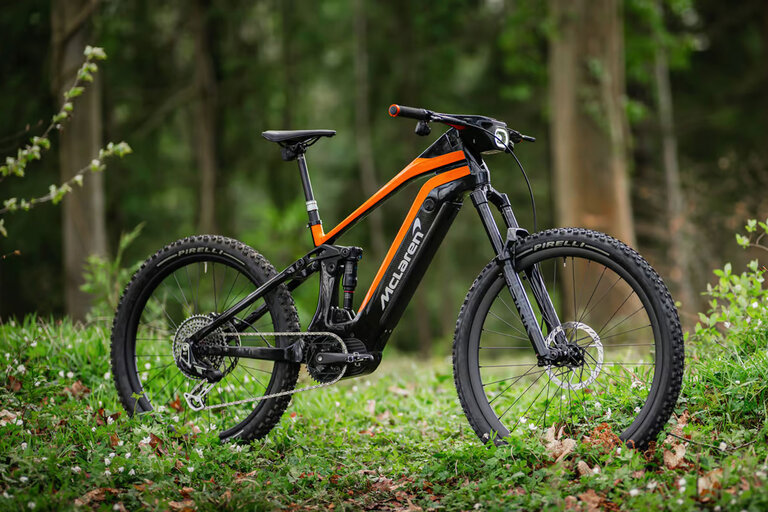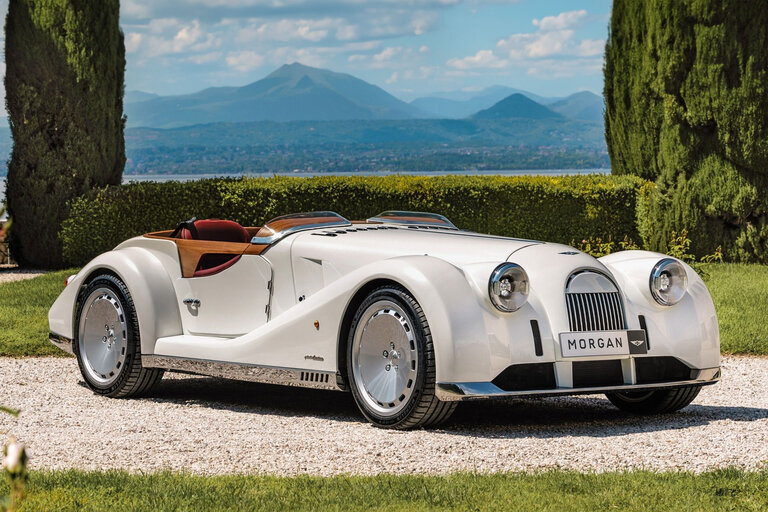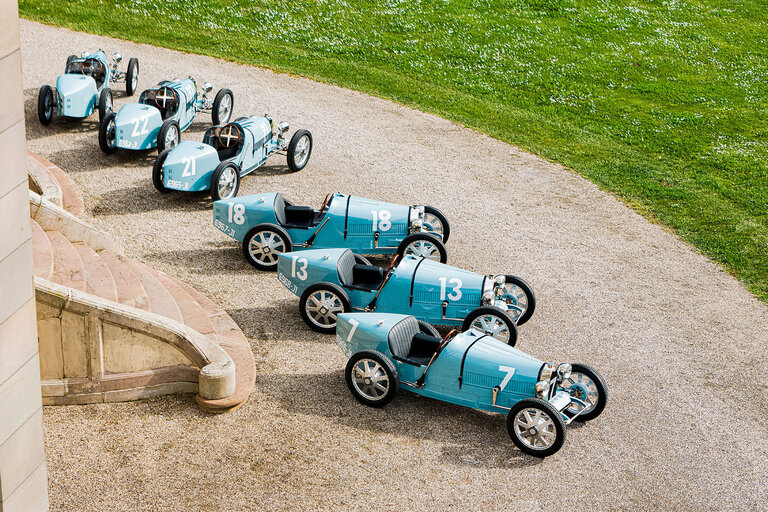
From the April 1991 issue of Car and Driver.
This is a territorial dispute, a grudge match between two longtime enemies determined to dominate one another—and determined to gain control of the turf they have fought over for years. These are two wild animals sharing one clearly focused purpose: speed. Beneath the skin-tight sheetmetal, their ferocious hearts pound with pent-up power. They prowl the streets like jungle cats.
The Porsche 911 Turbo and the Chevrolet Corvette ZR-1 are predators of the road.
The rivalry between these two models goes back to 1965, the year the 911 first appeared. These two cars have always tried to achieve the same goals—all-conquering performance and handling—but in vastly different ways. The German approach emphasizes Son of Beetle technology: the six-cylinder engine is smaller in displacement, air-cooled, and horizontally opposed, and it’s shoehorned into the stubby tail of a compact, lightweight body. Everyone knows the American way: more is better. A husky steel chassis is wrapped in fiberglass skin and stuffed with a massive, front-mounted V-8.
Over the years, the battle for superiority has shifted back and forth, as first one and then the other upped the ante with a variety of strategies: better suspensions, more power, more efficient aerodynamics. This perennial contest has resulted in the two cars you see here, the most powerful versions of the Corvette and 911 ever sold in America.
There is scant dissent that the ZR-1 is the most stupefying Corvette ever produced. In tests it has proved to be a true supercar, but it continues its roughneck tradition—heavy on brute force, dizzying speed, and race-car handling but lacking in grace and refinement. It’s still a wild thing, one of the wildest automobiles this side of a $400,000 Ferrari F40.
Going into this test, the new 911 Turbo posed a number of questions. Its predecessors, sold here off and on since 1978, have had a legendary history of alternately delighting and intimidating their drivers. Their chassis had an ornery streak, their powerful turbocharged engines suffered from hairy all-or-nothing response to the throttle, and their price tags were funnier than Rodney Dangerfield. And, of course, their fat-fendered bodies looked mean enough to make Corollas quake.
This new Porsche, however, is based on the thoroughly modernized Carrera 2 chassis. A perusal of its spec sheet indicates that it should be even hotter than before: its reworked 3.3-liter flat six is rated at 315 horsepower at 5750 rpm, up 33 horses from the last turbo. It boasts the fattest tires ever fitted to a 911 chassis. Its brake rotors are made from the same high-temperature alloy used on Porsche’s 962 endurance racers. It packs an innovative limited-slip differential that not only improves driving traction, but can lock up under simultaneously braking and cornering to improve stability. But is this enough to make it the baddest cat in the asphalt jungle?
To find out, three C/D editors embarked on a three-day, 1300-mile, total-immersion experience. Hard driving had to be part of the trial, so we included a large dose of rural two-lane, and we dropped in at a race circuit to let these big cats really stretch out—the better to judge the capabilities of these nasty boys without worrying about sliding off into Uncle Fred’s front yard.
There would be plenty of routine driving too: stop-and-go city traffic and long miles on Midwestern Interstates. After all, even a wild animal of the road is hemmed in by reality most of the time. Would either car be impossible to live with when the pace slowed down?Our trek began on the Atlantic docks in Charleston, South Carolina, where the Porsche Turbo arrived from Germany.
From Charleston we headed down the coast to Savannah, Georgia, home of the Roebling Road race circuit. Roebling’s combination of ample straightaways and daunting high-speed sweeps was tailor-made for powerful sports cars.
From there we scratched our way north on the kind of roads they write songs about: writhing two-lanes through North Carolina’s Nantahala National Forest and the Great Smoky Mountains National Park (which North Carolina shares with Tennessee). We roared through enchanted forests and quiet valleys, past tin-roofed cabins with pungent smoke curling from their chimneys. The long final leg, Knoxville to Ann Arbor, was on mind-numbing Interstate.
But something else happens when you go on a long trip with cars of this nature. Cars like these can change your life, even if your affair with them is short. They confer power and authority and presence upon the driver. People respond differently around them. Things happen that feel extraordinary. You are stared at, examined, considered; the pedestrians wonder who you are. So, all the while, we were on another kind of uncharted trip, the route up in the head.
The effect is mildly narcotic, and it persuaded us to add a special category to the ratings chart that would reflect the mesmerizing effect these cars had on us and the people we came in contact with. We call it the “audacity rating.”
Right here, pause and listen to the voice of another editor on the trip:
The convenience-store cashier tells us that Becky’s Home Cooking Restaurant is only a few blocks away. But we are strangers, and the signs in Rosman, North Carolina, are not so clear to us Yankees, and soon we have to stop and ask again. We ask a telephone repairman. “Bake-ees ?”he says, correcting our Northern pronunciation. “Why, it’s rayt dahn nair. Isstreet: raytdahnair. ” So it is, and across the street is an audience: a dozen adolescents digging a drainpipe ditch for their high school. As we rumble toward them, the shoveling stops. Their heads swivel in unison, like deer sensing movement.
As we exit the lot after the meal, our audience is twirling their fingers at us, signaling us to squeal the tires. Leaving positive impressions on young minds is a civic duty, but we hesitate, noting a county patrol car parked up the street. Rich gets on the 911 anyway, but as soon as it heaves forward with boost, there is the officer, walking toward his car. Wheeeeeechugaluga … the 911 lurches back down, and we coast by him at idle, looking straight ahead. Wonder if the kids got their nickel’s worth… —Don Schroeder
Second Place: Porsche 911 Turbo
If audacity were all that counted, this contest would have been decided before it began. The 911 Turbo is Mr. Universe in a $1500 Italian suit. Its bulging sheetmetal and massive rear wing promise race-car performance. Its flawless bodywork and mirror-like finish suggest images of white-coated craftsmen fitting each part with meticulous care—which is not all that far from the truth. The car looks very, very expensive, which of course it is.
HIGHS: Sinus-clearing performance, 180-proof audacity.
LOWS: Looney Tunes price, nervous handling.
How expensive? Try $105,191. And our car came with just one add-on option: the $891 limited-slip differential. The price does include both the new federal luxury tax and the gas-guzzler tax.
For that kind of scratch, it’s at least reassuring to discover that the 911 Turbo is rife with elegant engineering. The suspension’s control arms are beautiful forged-alloy pieces. The brake rotors are cross-drilled like a race car’s for maximum cooling. Look under the rear bumper’s left corner and you’ll notice that the turbocharger waste-gate outlet pipe is fitted with its own miniature catalytic converter.
The 911 Turbo’s cabin is a mix of expensive Old World craftsmanship and just plain old. The soft leather on the four-spoke, air-bag-equipped wheel would do a very fine pair of gloves just swell. (You can option yourself to death as regards leather.) The pedals still hinge at the bottom, Beetle-style. Every piece of trim is impeccably battened down.
The dash remains the old 911 design: the gauge arrangement is still one of the best, with a tach the size of a salad plate located squarely in front of you. But the switchgear, much of it added over the years, is strewn about the instrument panel haphazardly. To Porsche’s credit, it has managed to stuff a passenger-side air bag into the ancient dash layout.
Here’s another voice:
Unlike the nasty north in winter, South Carolina is all sunshine, so Deputy Slide Rule Schroeder cannot tolerate one more minute behind the wheel of a Corvette ZR-1 coated with Kosher-size salt chunks and grease globules from Michigan and Ohio. We pull into Bob’s Car Wash in Columbia. Bob’s is crowded. Just before our turn on the roller track, we measure the Vette’s left-rear tire to be sure it will fit. It’s 12.75 inches wide; the track of the car wash is a tenth of an inch wider. Could be close. Ten feet into the wash, the Vette gets stuck, and refuses to move forward into its bath. Schroeder must back it out over the rollers, holding up a restless crowd. Luckily, they’re too amused that our fancy car will have to be hand-washed in Bob’s driveway to be angry. We don’t get the Glow Wax, but we don’t have to pay, either. Thanks, Bob. —Phil Berg
The view out of the 911 is very un-sports-car-like. You sit bolt upright in the deeply winged seats, and you crank the seatback up even further in order to make the long reach to the steering wheel. The 911 is noticeably taller than the Vette, five inches in fact. The front window is nearly vertical, and the hood is short—this is a rear-engined car, remember—so the view out is superb. Your field of vision could not be better even if you sat on the hood.
Even if Porsche had put a ’51 Studebaker body over this chassis, you’d know what was underneath by the time you got a mile down the road. Everything your five senses register harks back through 25 years of Porsche 911 history. The engine, for instance, emits the same hard-edged thrum Porsche flat sixes have always made. And why not? It’s a mildly reworked version of the previous model’s single-turbo 3.3-liter powerplant. Even its Jekyll-and-Hyde personality is there, though more subtle than before. At low revs the big turbocharger is barely ticking over, and the engine feels like it has its feet up on the desk; you have time to recite the first stanza of Beowulf before the boost comes up. But above three grand, the 911 Turbo is on a caffeine high. Put your foot down and hold on: the speedo needle blurs past 60 mph in 4.4 seconds and you’re through the quarter-mile in 12.9 seconds at 108 mph.
The Turbo’s parentage really comes into focus when you press hard. Drive it to 85 percent of its cornering potential and it’s sweet and sophisticated. It reacts confidently. The steering is sensitive and accurate, with just the right weighting. And no 911 Turbo was ever so stable in a straight line at speeds above the century mark.
But turn it loose on a back road looking for that last fifteen percent and the Turbo acts up in much the manner of the previous version. It is a double handful in the corners, pitching and twitching like it longs to visit that ditch—a disobedient, thrusting animal trying to break its leash, or, if it doesn’t get its way, its own neck. On the racetrack, the Turbo’s mean streak made us conservative and kept it from getting within two seconds a lap of the ZR-1.
It sure sounded good:
What kind of noise does $170,000 buy? The right kind, if you’re watching these cars from the finish line at the half-mile front straightaway of Roebling Road. Even under full throttle, the 911 Turbo approaches with an uncanny, freight-train-like silence. But as it passes, the hint of rushing wind transforms into an explosion of guttural ripping. On the other hand, the 911 is a gentleman compared with the ZR- 1, which, when flat out, seems like a car gone mad. Rounding the final curve in third gear, it cries out, clearly audible and urgent, its rising wail becoming almost frightening as it approaches and blasts past at more than 120 mph. A straining LT-5 is a great conversation stopper. —Don Schroeder
When the stunt driving is through, you’ll find that the 911 is a decent, though not exceptional, long-distance companion. The ride is stiff. The engine is reasonably subdued, but road noise rolls through the cabin, and the rigid body registers each tar strip with a loud pong! worthy of a timpani drum. For a car bearing this price burden, the 911 ought to be equipped with a sound system better matched to its difficult acoustics; the one in our car sounded muddy when we turned it up enough to counter the rumble of the road.
THE VERDICT: An awesome dude in a silk shirt.
But doubtlessly, this is one hell of a car. Masculine, powerful, threatening, beautiful, and fast. German. Unfortunately, it comes with one hell of a price tag. That, more than anything else, is what relegated it to a close second-place finish.
First Place: Chevrolet Corvette ZR-1
The ZR-1 triumphed over the 911 Turbo for one simple reason: it goes fast better. A ZR-1 in full stride is a highly talented athlete. It’s always on its toes. Its moves are intuitive. Its speed is sudden and explosive. If you lust after a ZR-1 for any other reason than the thrill it delivers when you hammer it, perhaps you will be disappointed.
HIGHS: Racing-car speed, handling to match.
LOWS: Off-the-rack look interior quality needs work.
Unlike the Porsche, the Vette is not a car for preening. For one thing, there’s nothing about it that’s exclusive—at least not visibly. This year, every Corvette shares the ZR-1’s concave tail, and all Vettes wear the same new nosepiece. Only a small ZR-1 badge and few subtle body parts set it off. We’re convinced that our ZR-1 got all the attention it did because it was always in the company of the strutting Porsche.
The ZR-1 doesn’t exhibit the fit-and-finish quality one is entitled to expect in a $64,000 car. The interior fit seems half-hearted, and some of the inside plastic has a decidedly low-ball look. Some items as the hard-to-read gauges and the fluttery hood failed to meet the quality expectations engendered by the wonderful powertrain. Even the transmission on our car rattled ominously at idle, and it’s a sound we’ve heard before from other Corvettes.
Time out for a sobering observation:
Speed enforcement appears to be the growth industry of the South. We’re subjected to more microwave interrogations in one day than we deal with in a month up North. Now we’re getting zapped again. What’s with these guys? We’ve been on the road only an hour, and already we’ve seen seven patrol-cars. That’s one every nine miles. The troopers are cagey, too. An ice-blue Thunderbird—unmarked, of course—has one poor sucker pulled over. A black T-Bird running radar passes us a half-mile down the road. We see a silver Mustang and a black-and-white Taurus going the other way on South Carolina I-385. You’ll never pick them out in your mirror. The most depressing part about this constant police omnipresence is that it works. Everyone on the road is cowed. No one dares venture more than five over the limit. Not even us. —Rich Ceppos
Put the ZR-1 into motion and you’ll forget all about things like upholstery and shaky hood panels. You sit down low, in a thick-walled cocoon, but the initial feeling of isolation melts away in moments. The deeply pocketed seats are excellent, and the shifter, wheel, and pedals are positioned perfectly.
The first surprise is the ZR-1’s ride: it can do a fair impression of a sedan, if you ask that of it. The key is the standard-equipment electronically controlled shock absorbers, which offer three damping programs, ranging from plush to racer-stiff. (We found the middle setting best for all-around use.) This roughneck indeed has table manners.
Fortunately, not too many manners. The big V-8 makes sure of that. Lots of displacement—5.7 liters in all—breathing through 32 valves makes for instant lunge whenever your right foot twitches. Our test car was slightly slower than other ZR-1s we’ve driven, but it still managed a zero-to-60 pass in 4.9 seconds and a quarter-mile blast of 13.2 seconds at 108 mph. And the sounds—great booming, thrashing howling blasts—stand your wrist hair on end.
Meanwhile, out on the highway:
The 911 Turbo and the ZR-1 are the sharks of the Interstates. Our test cars attract these pilot fish, these remoras, which cling to our flanks. Two of these tailgaters make dangerous moves just to keep close on northbound I-75. A Georgia-plated Passat latches onto the back of the ZR-1 and stays there from Tennessee to Cincinnati. When we pull off the freeway for fuel, to make the exit behind us, the Passat cuts off a hapless Mazda pickup. We leave him at the pumps, but fifteen minutes of VW-flogging returns him to our draft. Of special note is a Suzuki Swift from South Carolina containing two girls and an infant that keeps up with our 85-mph pace. A Pontiac 2000 and a Mercedes 300CE, both from Ohio, trade tailgating spots with the Suzuki, making our convoy a conspicuous train of five cars. (Hey, let’s all room together next semester!) It makes no difference if we slow to a crawl, none of our pilot fish will pass the sharks. Even a quick blast to 140 mph fails to shake them permanently; our unwelcome followers drone along determinedly until they catch up. A gunmetal-gray Legend would be much easier—and safer—to drive across the country. —Phil Berg
The Vette’s behavior on twisting two-lane roads is every bit as exciting as what it does in a straight line. It goes where you aim it. Period. No feints, lurches, or false moves. It hangs on as if it had giant asphalt-piercing spikes in its tires. The Corvette ZR-1 is the equivalent Isiah Thomas: both do the seemingly impossible moves and somehow make it look easy.
Ease off to catch your breath and it’s apparent that the Vette is a thoroughly docile creature around town. The controls are light and precise, and every amenity except heated seats is on duty to serve you. You could commute to work in this car.
THE VERDICT: A wild animal you can live with—barely.
But when you slow down and mingle with the ordinaries, it becomes for all the world just another Corvette. You have to love this car for the wild animal within, and nothing more.
Csaba’s Excellent Acceleration Test
Before we clocked the ZR-1 and the Porsche Turbo, all three writers who participated in this comparison test seemed to think the Corvette was the slightly quicker car. Yet during instrumented testing, the Porsche easily out-dragged the Corvette. Do our writers have lousy seat-of-the-pant feel, or is there something else going on here?
What we’re seeing is the difference between track testing and street driving. When we measure acceleration at the track, we do whatever it takes to get the quickest times, short of exceeding the engine’s redline, and we don’t do any “speed” or “power” shifting (shifting with the accelerator to the floor and giving the clutch a quick, synchronized jab of the foot).
For best results, we usually abruptly release the clutch (“drop” it) at high rpm to spin the tires and get the car moving quickly. The ideal clutch-release rpm is one that lets the spinning rear tires hook up with the pavement just as the engine surges upward into the heart of its power band.
For cars powered by turbocharged engines, which are usually relatively small in displacement and therefore gutless until the turbocharger spools up, this approach can make for a dramatic start. For example, the ideal clutch release for the 911 Turbo was a tire-smoking 4500 rpm, which yielded a zero-to-60-mph run of 4.4 seconds.
By comparison, the ZR-1 has less traction and much more low-end power than the Porsche. As a result, a relatively non-violent clutch engagement around 2000 rpm produced the optimal start, resulting in a 4.9-second zero-to-60 clocking.
Although the 911 Turbo turned out to be quicker than the ZR-1 by half a second, how many Porsche owners would whip their $100,000 mounts hard enough to prove it on the street? Even aggressive real-world driving relies on starts more like the Corvette’s than the Porsche’s, and that’s why our writers perceived the ZR-1 to be the quicker car.
We’ve considered creating a test to measure realistic, everyday street performance to go along with the all-out track tests. The problem was developing a moderate launch procedure that we could repeat perfectly day after day on car after car.
That turned out to be impossible, so we found another solution. Instead of starting from rest, we would initiate an acceleration test from 5 mph with the car in first gear and the clutch fully engaged. This approximates the performance of a gradual launch while eliminating most of the variables.
At 5 mph, the Porsche’s 3.3-liter, low-compression engine is turning about 750 rpm and the turbocharger is asleep; consequently there’s minimal power. Hit the throttle and it takes about a second to get going before it blasts off, reaching 60 mph in 5.7 seconds.
Likewise at 5 mph, the ZR-1 produces just 625 rpm, but its 5.7-liter high-compression V-8 responds instantly and quickly hits its stride, pushing the Vette to 60 mph in 5.3 seconds and beating the Porsche.
We’ve experimented with this test on other cars, as shown in the table here. With an automatic transmission, the street-start procedure leaves the transmission in drive and doesn’t allow brake torquing (building boost or engine rpm by using the brakes to load the engine).
ACCELERATION TO 60 MPH
|
Car |
Track start |
Street start |
|
Buick LeSabre (auto) |
10.1 |
10.1 |
|
Dodge Stealth R/T Turbo |
5.9 |
6.8 |
|
Mazda Protege LX |
8.8 |
9.7 |
|
M-B 300D 2.5 Turbo (auto) |
11.2 |
12.2 |
|
Mercury Capri XR2 |
7.9 |
8.8 |
|
Nissan 300ZX Turbo (auto) |
5.9 |
6.5 |
|
Porsche 928GT |
5.2 |
5.5 |
|
Toyota Calica GT-S |
9.5 |
10.3 |
|
Volvo 740 Turbo (auto) |
7.2 |
7.5 |
Cars whose engines are peaky or suffer turbo lag, such as the Mazda Protege LX and the Dodge Stealth R/T Turbo, lose about a second in the street start. Cars with lots of torque and well-matched drivetrains, like the Porsche 928GT and the Buick LeSabre, don’t suffer much at all.
This new test will never replace balls-out track testing as the ultimate measure of a car’s acceleration. But as the 911 Turbo and the ZR-1 results show, it gives us a better idea about how easily that performance can be achieved in everyday driving. Look for it in future tests. —Csaba Csere
This content is created and maintained by a third party, and imported onto this page to help users provide their email addresses. You may be able to find more information about this and similar content at piano.io
Source link





